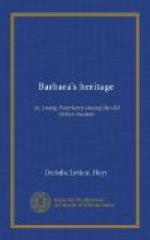“I was delighted,” interpolated Malcom, “with the story of his first painting for this building, and the audacity that gained for him the commission to paint one picture for it every year of his remaining life.
“And here are about fifty of them,” resumed Mr. Sumner, “in which we may study both his strength and his weakness. No painter was ever more uneven than he. No painter ever produced works that present such wide contrasts as do his. He could use color as consummately as Titian himself, as we see in his masterpiece, The Miracle of St. Mark, in the Academy; yet many of his pictures are almost destitute of it. He could vie with the greatest masters in composition; yet there are many instances where he seems to have thrown the elements of his pictures wildly together without a single thought of artistic proportions and relations. In some works he has shown himself a thorough master of technique; in others his rendering is so careless that we are ashamed for him. But all this cannot alter the fact that he is surpassingly great in originality, in nobility of conception, and in a certain poetic feeling,—and these are qualities that set the royal insignia upon any artist.”
“I cannot help feeling the motion, the action, of all these wild figures,” exclaimed Bettina, as she stood looking about in a helpless way. “I seem to be buffetted on all sides, and the pictures mix themselves with each other.”
“It is no wonder. No painter was ever so extravagant as he could be. There is a headlong dash, an impetuous action in his figures when he wills, that remind us of Michael Angelo; but Tintoretto’s imagination far outran that of the great Florentine master. Yet there is a singular sense of reality in his most imaginative works, and it is this, I think, that is sometimes so confusing and overwhelming. His paintings here are so many that I cannot talk long about any particular one. I will only try to tell you what qualities to look for—then you must, for yourselves, endeavor to understand and come under the spell of the personality of the artist.
“In the first place,” he continued, “look for power—power of conception, of invention, and of execution. For instance, give your entire attention for a few minutes to this Massacre of the Innocents. See the perfect delirium of feeling and action—the frenzy of men, women, and children. Look also for originality of invention. Combinations and situations unthought of by other painters are here. There is never even a hint of plagiarism in Tintoretto’s work. In his own native strength he seizes our imagination and, at will, plays upon it. We shudder, yet are fascinated.”
“Oh, uncle! I don’t like it!” cried Margery, almost tearfully. “I don’t wish to see any more of his pictures, if all are like these.”
“Madge—puss,” said Malcom, “this is a horrible subject. Not all will be like this.”
“No, dear,” said her mother, sympathizingly, “I don’t like it either. You and I will choose the pictures we are to look at long. There are many of Tintoretto’s that you will enjoy, I know,—many from which you can learn about the artist, as well as from such as these.”




